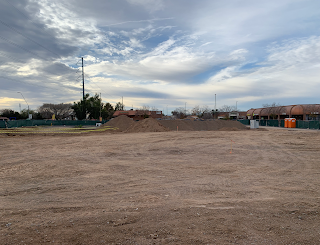Why parking lots were moved to the front of businesses in Phoenix, Arizona
If you look at old photos of Phoenix, Arizona, you will see signs that direct you to the parking lots, which were behind the buildings. Some of the older parts of Phoenix, and Los Angeles, have parking lots behind buildings, but most parking lots for the last fifty years have been put in front of buildings. And there's a reason for that, it just has to do with human nature, and how people in cars have learned whether a business is open.
The neighborhood where I grew up, back in Minneapolis, was built in the 1920s, in what I called the "Model T era" (actually it was more of the Model A era), but it was a time when there were cars, but everything hadn't started becoming "car scale". The businesses were right up by the street, and the parking lots were in the back of the building. You could walk along a sidewalk, and be just a couple of steps from the door, or you could get off the bus, and walk immediately into the building. You were close enough, as a human, to see signs that said "Open". You might even see people inside, or people walking in and out of the building. You might see that the door is open.
But that changed in about the mid-fifties, with car scale, when people had to determine whether a business was open from a very long distance, and while traveling at fairly high speeds, especially in Phoenix which has such big main streets that they're practically "mini-freeways". So businesses learned to use cars parked in the parking lots to tell people driving by that they were open.
A modern example that I like to point to is the Home Depot. Whether there's an open sign that can be seen from the street, I have no idea. To see if Home Depot is open, I look for cars in the parking lot. The same way with grocery stores, just about everywhere I go to in my suburban neighborhood, which began in the 1980s, and is still growing. Parking lots are out front, and they tell people in cars that the business is open. By the way, if you ever wondered why restaurants and bars give discounted prices (happy hour), it's to put cars in the parking lot. People see the cars, and figure that it's the place to go, and stop there. Just good Marketing.
Support Arizona history by becoming a patron on Patreon
Click here to become a Patron!
History Adventuring blog posts are shared there daily, also there's "then and now" photos, billboards, aerials, and super high-resolution photos of historic Phoenix, Arizona
Now waitaminute, I'm not criticizing people, and saying that they can't read signs - they just ignore them, we all do, and for good reason. I rolled up to the Fitness Center last Saturday morning and didn't see any cars in the parking lot, so I had to go up to the door and open it to determine that they were open. There's no other way to know - no "open" sign, nothing. And even if they had an "open" sign, if there were no cars in the lot I would have figured that someone just forgot to turn the sign off the previous night. When a car parked in the lot I felt better.
The net effect of this is a very unfriendly scale for humans who are not using cars. As someone who walks, pedals, and takes public transportation, often I find that the distance that I have to go from the street to the building (which at Home Depot is about 100 yards) is a sizable distance, even if there's a sidewalk from the street (and there rarely is). It's a "gauntlet" walking, or pedaling, through a parking lot. Parking lots are great places for cars, terrible places for bicycles and pedestrians. So everything is designed for cars, not little tiny human beings. And businesses did that because most of their business comes from people arriving in cars, and then it's reinforced because the only way to use those businesses is to have a car. People pull up to Home Depot in vehicles, they don't walk there, and they don't pedal there. My local Home Depot, which was build no more than fifteen years ago, has no bike rack. And just the thought of it seems kinda silly - who pedals to Home Depot? Well, I do.
So the next time you look at a business that's not "human scale", and see acres of asphalt in front of it, you'll know why. Just good marketing strategy.
Image at the top of this post: Jim's Steak House in the 1960s, 21st Place and McDowell, Phoenix, Arizona. Even a big sign that said "Free Parking", with neon, isn't as effective as having a parking lot that's viewable from the street.




Comments
Post a Comment